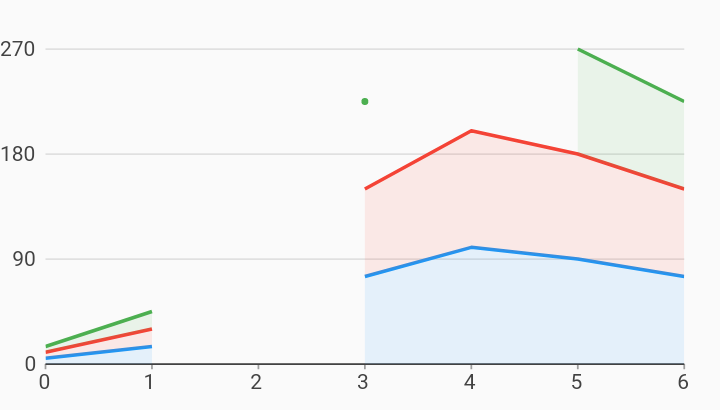community_charts
Stacked Area Nulls Line Chart Example

Example:
/// Example of a stacked area chart with null measure values.
///
/// Null values will be visible as gaps in lines and area skirts. Any data
/// points that exist between two nulls in a line will be rendered as an
/// isolated point, as seen in the green series.
///
/// In a stacked area chart, no data above a null value in the stack will be
/// rendered. In this example, the null measure value at domain 2 in the Desktop
/// series will prevent any data from being rendered at domain 2 for every
/// series because it is at the bottom of the stack.
///
/// This will also result in an isolated point being rendered for the domain
/// value 3 in the Mobile series, because that series also contains a null at
/// domain 4.
import 'package:community_charts_flutter/flutter.dart' as charts;
import 'package:flutter/material.dart';
class StackedAreaNullsLineChart extends StatelessWidget {
final List<charts.Series> seriesList;
final bool animate;
StackedAreaNullsLineChart(this.seriesList, {this.animate});
/// Creates a [LineChart] with sample data and no transition.
factory StackedAreaNullsLineChart.withSampleData() {
return new StackedAreaNullsLineChart(
_createSampleData(),
// Disable animations for image tests.
animate: false,
);
}
@override
Widget build(BuildContext context) {
return new charts.LineChart(seriesList,
defaultRenderer:
new charts.LineRendererConfig(includeArea: true, stacked: true),
animate: animate);
}
/// Create one series with sample hard coded data.
static List<charts.Series<LinearSales, int>> _createSampleData() {
final myFakeDesktopData = [
new LinearSales(0, 5),
new LinearSales(1, 15),
new LinearSales(2, null),
new LinearSales(3, 75),
new LinearSales(4, 100),
new LinearSales(5, 90),
new LinearSales(6, 75),
];
final myFakeTabletData = [
new LinearSales(0, 5),
new LinearSales(1, 15),
new LinearSales(2, 25),
new LinearSales(3, 75),
new LinearSales(4, 100),
new LinearSales(5, 90),
new LinearSales(6, 75),
];
final myFakeMobileData = [
new LinearSales(0, 5),
new LinearSales(1, 15),
new LinearSales(2, 25),
new LinearSales(3, 75),
new LinearSales(4, null),
new LinearSales(5, 90),
new LinearSales(6, 75),
];
return [
new charts.Series<LinearSales, int>(
id: 'Desktop',
colorFn: (_, __) => charts.MaterialPalette.blue.shadeDefault,
domainFn: (LinearSales sales, _) => sales.year,
measureFn: (LinearSales sales, _) => sales.sales,
data: myFakeDesktopData,
),
new charts.Series<LinearSales, int>(
id: 'Tablet',
colorFn: (_, __) => charts.MaterialPalette.red.shadeDefault,
domainFn: (LinearSales sales, _) => sales.year,
measureFn: (LinearSales sales, _) => sales.sales,
data: myFakeTabletData,
),
new charts.Series<LinearSales, int>(
id: 'Mobile',
colorFn: (_, __) => charts.MaterialPalette.green.shadeDefault,
domainFn: (LinearSales sales, _) => sales.year,
measureFn: (LinearSales sales, _) => sales.sales,
data: myFakeMobileData,
),
];
}
}
/// Sample linear data type.
class LinearSales {
final int year;
final int sales;
LinearSales(this.year, this.sales);
}